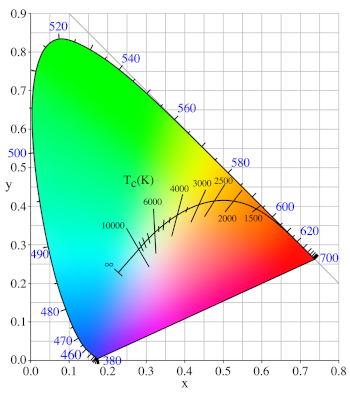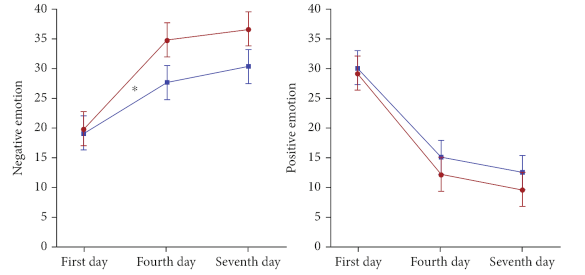Mood Lighting
September 5, 2022
Just a few
decades ago, everyone read from
print media, and
display management was easy. If the
room was too
dark for
reading, you needed to turn on a
light. Today, it's possible to read from a
tablet computer in a totally dark room.
research was done in the
early days of computing to determine which
text mode was more readable,
black characters on a
white background, as in a printed
book, or white characters on a black background, commonly called
dark mode. Having a background that matched the room background was found to be beneficial; so, your tablet display should have white characters on a black background when reading in a dark room. I
personally find that
annoying, and there's the further problem of how
images in dark mode are
rendered.
A
median effort, called
Night Shift, was introduced by
Apple a few years ago. This mode lowered the
color temperature of the display by shifting it towards
yellow, thereby reducing
blue. All
light, but especially blue light, suppresses
melatonin biosynthesis,[1] so the
conjecture was that such a color shift will aid
sleep after
nightime reading. However, a recent
study showed no differences in sleep outcomes attributable to Night Shift, and not using a display resulted in better
sleep quality than using a Night Shift display.[2]

The CIE 1931 x,y chromaticity space, a typical representation of the visual colors.
The quality of a display is measured by how much of an area of the space can be represented, a so-called color gamut. The unusual word, gamut, means "the complete range or scope of something."
This diagram shows also the black-body colors at various temperatures. The color temperature of the Sun is about 5780 K.
The CIE 1931 color spaces were designed by the International Commission on Illumination (Commission Internationale de l'éclairage). They were the first quantitative links between the wavelengths in the visible spectrum and the perceived colors in human color vision.
(Wikimedia Commons image by PAR. Click for larger image.)
Human vision is
amazing, as
evidenced by the fact that most people can discern a
candle flame at 48
kilometers (30
miles) on a
clear, dark
night.[3] As most of us will remember from our
high school biology class,
night vision is enabled by
retinal rods, and color vision is enabled by
retinal cones. The
human eye has three types of cone
cells, and each of these can discern about 100 different color shades; so, humans can distinguish about a million colors.[3]
Some people, mostly
women, have a
genetic mutation for a fourth cone cell. In
theory, these
tetrachromats can see 100 million colors.
Color-blind people (
dichromats) have just two types of cone cells and presumably can see just 10,000 colors.[3] I worked with a
laboratory technician who was "doubly-
cursed" in being both
left-handed and color-blind (left-handedness is completely accepted today, but
not in years past). How can I not include a mention of one
famous left-handed individual,
Ned Flanders. Some people who have had
cataract surgery in which the eye's normal
lens is replaced by an
artificial lens have reported the ability to see
ultraviolet light.
Nearly all
computing devices display colors by a simple
technique in which the values of the
primary colors, red,
green, and blue, are expressed as
8-bit values. This
24-bit representation in which 16,777,216 colors are displayed is known as
true color, and it's far in excess of the typical million colors of human vision.

Sometime in the history of computers, images of parrots became associated with color displays, a likely consequence of their colorful plumage.
Shown is an Eastern Rosella (Platycercus eximius) female parrot from Tasmania.
(Wikimedia Commons image by JJ Harrison. Click for larger image.)
Now that we understand the bad affects of lighting color, is there any way that lighting color can enhance mood? That's the question researched by a team of
scientists from the
European Space Agency (Netherlands), the
University of Leeds (Leeds, UK), the
Hochschule für Medien, Kommunikation und Wirtschaft (Berlin, Germany), the
Xiangtan University (Xiangtan, China),
Leiden University (Leiden, Netherlands),
Vrije Universiteit (Amsterdam, Netherlands), and Xiangtan Central Hospital (Xiangtan, China). [5-6] Their purpose was to address the
psychophysiological state of
crews on
manned space missions in which they live in a confined technological
environment devoid of the variety and variation they had on
Earth.[5-6]
Previous studies, such as the joint
National Science Foundation/
NASA Shared Cognitive Architectures for Long-term Exploration project and
NASA's Extreme Environment Mission Operations project, have found that crew members on long-term missions are extremely susceptible to
psychological problems. One contributing factor is the visual monotony and
monochromatic coloring of the environment.[6] At the inception of the
International Space Station, both NASA and the former
Soviet Space Agency believed that psychological problems would be a factor in the success of such long-term space missions.[5]
In deep space missions, the isolated and confined environment aggravates the crew's
anxiety,
irritability, and
depression.[5] Furthermore,
signal propagation delays will make astronauts feel the anxiety of being far away from Earth.[5] This
stress sometimes manifests itself in such things as unresponsiveness, intermittent
mania, and
crying.[5] As previously mentioned, light suppresses melatonin levels, and the color of light can have a significant role in
emotional regulation and
cognition.[5] In one study, a red room caused a lowered of the
heart rate compared to non-colored room, and a blue room had a
relaxing effect on
study participants compared with the red room.[5] For
astronaut health and safety, lighting in support of both
circadian regulation and psychological issues should be considered.[5]
The goal of the study was to test whether multicolored lighting can improve a person's psychological state in an isolated and confined environment over a period of seven
days.[5] The study was conducted at Xiangtan Central Hospital in
Xiangtan, China on ten
healthy male and ten
female's study participants of
Chinese nationality from Xiangtan University in their twenties.[5] The isolation rooms, 3.5
meters long, 3 meters wide, and 2.2 meters high, were
furnished with a
chair, a
table, a
bed, and a bedside table.[6] The
walls and the
ceiling were
painted white, the floor was dark
gray, and the door and furnishings were a light
wood color.[6]
The participants were
randomly divided into two groups of ten each, one group (the
control group) was exposed to a static, monotonous white interior, while the
test group was exposed to multicolored lighting randomly changed every three
hours.[5-6] The multicolor light source was a
Philips Hue Bluetooth wireless bulb, capable of displaying 16 million colors, placed in the middle area of the room.[6] The participants were not allowed to use
mobile phones,
computers,
televisions, or
iPads, but they could read
paper books, and their psychological state was tested on the first day, the fourth day, and the seventh day.[5-6]

Positive and negative emotional response during the multicolored lighting study for the test and control groups. The control group response, in red, is worse than that of the group exposed to the multicolored lighting. (Space: Science & Technology image.[6] Click for larger image.)
At the final day of the
experiment, the anxiety level for both the test and control groups was significantly higher than that on the first day.[6] The participants' negative emotions and anxiety increased to the fourth day, and then
plateaued, with the control group plateauing at a higher level (see figure).[5] It was concluded that multi color lighting alleviated the anxiety and negative emotions caused by isolation and confinement, and a random change of light color appeared to counteract the monotony of the isolation.[6] Such a simple
palliative would be useful in future
space exploration.[6] This may be the reason for unexplained
purple wigs of the
uniform of the female astronauts in the
1970s UFO television series by
Gerry Anderson and
Sylvia Anderson.
References:
- Kathleen E. West, Michael R. Jablonski, Benjamin Warfield, Kate S. Cecil, Mary James, Melissa A. Ayers, James Maida, Charles Bowen, David H. Sliney, Mark D. Rollag, John P. Hanifin, and George C. Brainard, "Blue light from light-emitting diodes elicits a dose-dependent suppression of melatonin in humans," Journal of Applied Physiology, vol. 110, no. 3 (March 1, 2011), https://doi.org/10.1152/japplphysiol.01413.2009. This is an open access article with a PDF file here.
- Kara M. Duraccio, Kelsey K. Zaugg, Robyn C. Blackburn, and Chad D. Jensen, "Does iPhone night shift mitigate negative effects of smartphone use on sleep outcomes in emerging adults?", Sleep Health, vol. 7, no. 4 (August 2021), pp. 478-484, doi:10.1016/j.sleh.2021.03.005.
- W. D. Wright, "A re-determination of the trichromatic coefficients of the spectral colours," Transactions of the Optical Society, vol. 30, no. 4 (March, 1929), pp. 141-164, https://doi.org/10.1088/1475-4878/30/4/301.
- Adam Hadhazy, "What are the limits of human vision?", BBC, July 27, 2015.
- Ao Jiang, Irene Lia Schlacht, Xiang Yao, Bernard Foing, Zhixiong Fang, Stephen Westland, Caroline Hemingray, and Wenhao Yao, "Space Habitat Astronautics: Multicolour Lighting Psychology in a 7-Day Simulated Habitat," Space: Science & Technology, vol. 2022 (April 9, 2022), Article ID 9782706, pp. 1-11, https://doi.org/10.34133/2022/9782706. This is an open access article with a PDF file here.
- How scientists tested the effect of multicolor lighting on improving people's psychological state, Beijing Institute of Technology Press Co., Ltd, Press Release, July 6, 2022.
Linked Keywords: Decade; print media; display device; management; room; darkness; dark; reading (process); light fixture; tablet computer; research; history of computing; early days of computing; text mode; black; character (symbol); white; book; light-on-dark color scheme; dark mode; opinion; annoyance; annoying; digital imager; rendering (computer graphics); median; Night Shift (software); Apple Inc.; color temperature; yellow; blue; melatonin; biosynthesis; conjecture; sleep; night; nightime; clinical trial; study; sleep quality; The CIE 1931 x,y chromaticity space; CIE 1931 x,y chromaticity space; depiction; representation; color vision; visual color; measurement; measure; area; two-dimensional space; color gamut; word; gamut; diagram; black-body; temperature; Sun; kelvin; International Commission on Illumination (Commission Internationale de l'éclairage); quantification; quantitative; wavelength; visible spectrum; visual perception; perceive; human color vision; Wikimedia Commons; User:PAR; amazement; amazing; scientific evidence; candle; flame; kilometer; mile; transparency and translucency; clear; night; high school; biology; class (education); night vision; photoreceptor cel; retinal rod; retinal cone; human eye; cell (biology); woman; women; genetic mutation; theory; color blindness; color-blind; laboratory technician; curse; cursed; handedness; left-handed; bias against left-handed people in years past; fame; famous; Ned Flanders; cataract surgery; lens (anatomy); lens (optics); artificial lens; ultraviolet light; computing device; technology; technique; primary color; green; 8-bit; 24-bit; true color (24-bit); Parrot, Eastern Rosella (Platycercus eximius) female; image; parrot; electronic visual display; color display; plumage; Tasmania; User:JJ Harrison; scientist; European Space Agency (Netherlands); University of Leeds (Leeds, UK); Hochschule für Medien, Kommunikation und Wirtschaft (Berlin, Germany); Xiangtan University (Xiangtan, China); Leiden University (Leiden, Netherlands); Vrije Universiteit (Amsterdam, Netherlands); psychophysiology; psychophysiological state; crew; human spaceflight; manned space mission; environment (biophysical); Earth; National Science Foundation; NASA; Shared Cognitive Architectures for Long-term Exploration project; NASA's Extreme Environment Mission Operations project; psychology; psychological; monochrome; monochromatic; International Space Station; Soviet Space Agency; anxiety; irritability; depression (mood); signal propagation delay; stress (biology); mania; crying; self-regulation theory; emotional regulation; cognition; heart rate; relaxation (psychology); human subject research; study participant; astronaut; occupational safety and health; circadian rhythm; circadian regulation; days; Xiangtan, China; health; healthy; male; female; China; Chinese; nationality; meter; furniture; furnished; chair; table (furniture); bed; wall; ceiling; paint; painted; white; gray; wood; randomness; randomly; treatment and control groups; test group; hour; Philips Hue Bluetooth wireless bulb; mobile phone; computer; television; iPads; paper; book; emotional response to colored lights; positive affectivity; negative affectivity; negative emotional response; electric light; lighting; Space: Science & Technology; experiment; plateau; plateaued; palliative; space exploration; purple; wig; uniform; 1970s; UFO television series; Gerry Anderson; Sylvia Anderson.